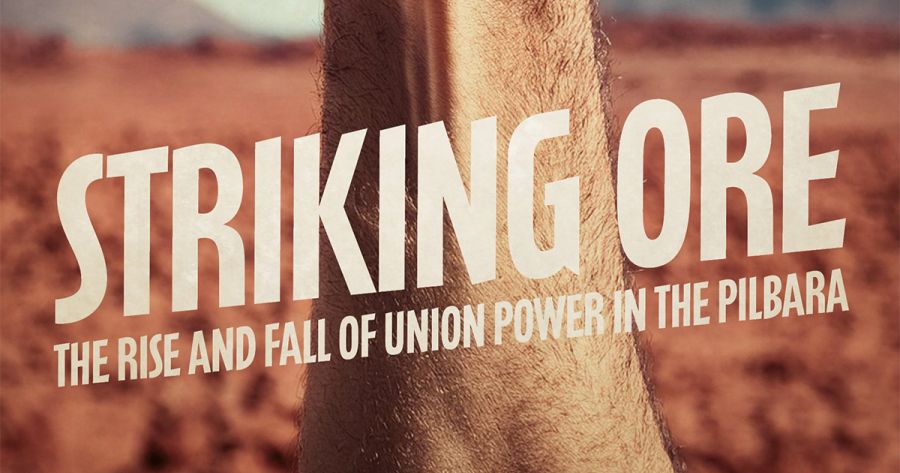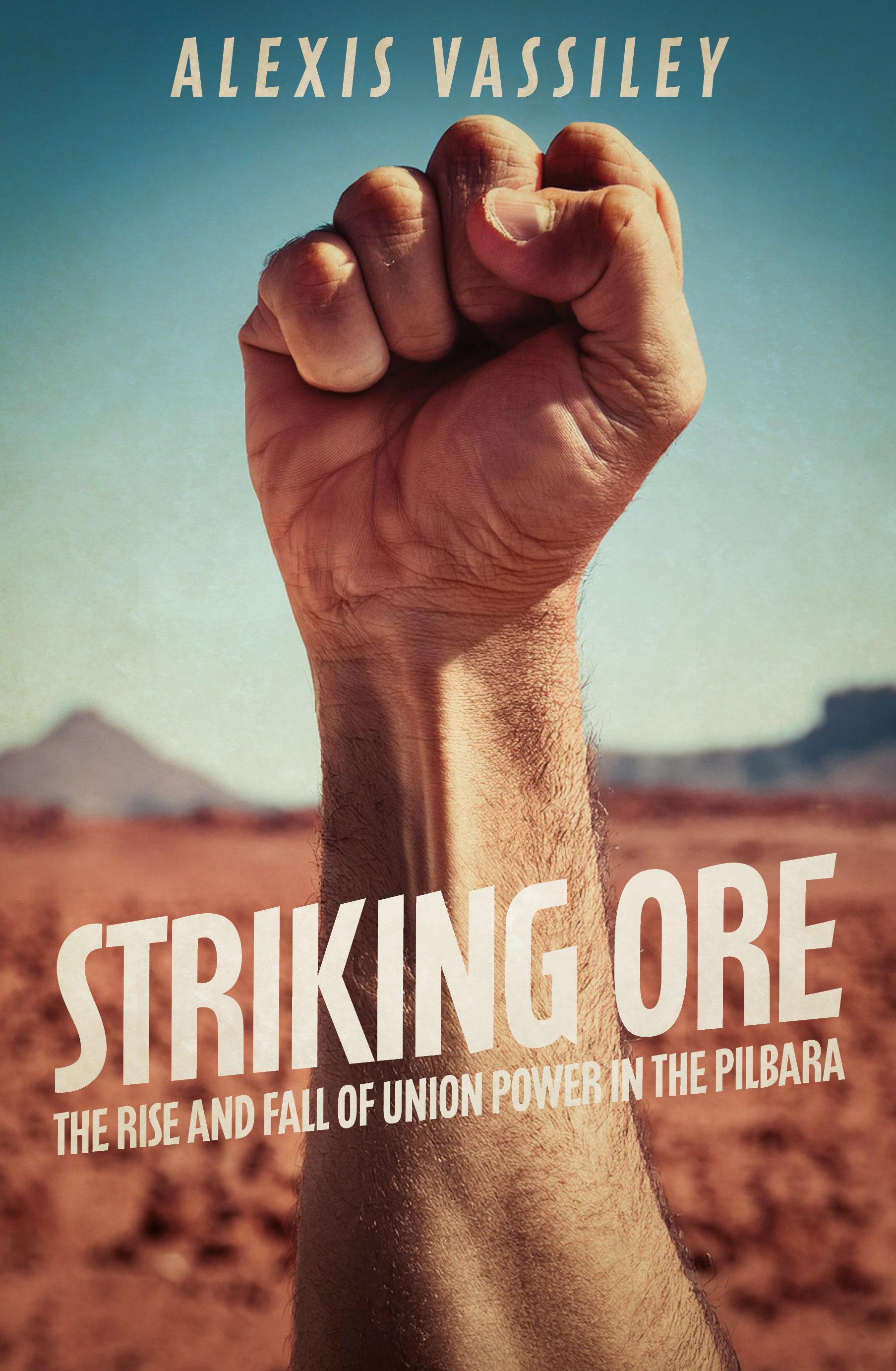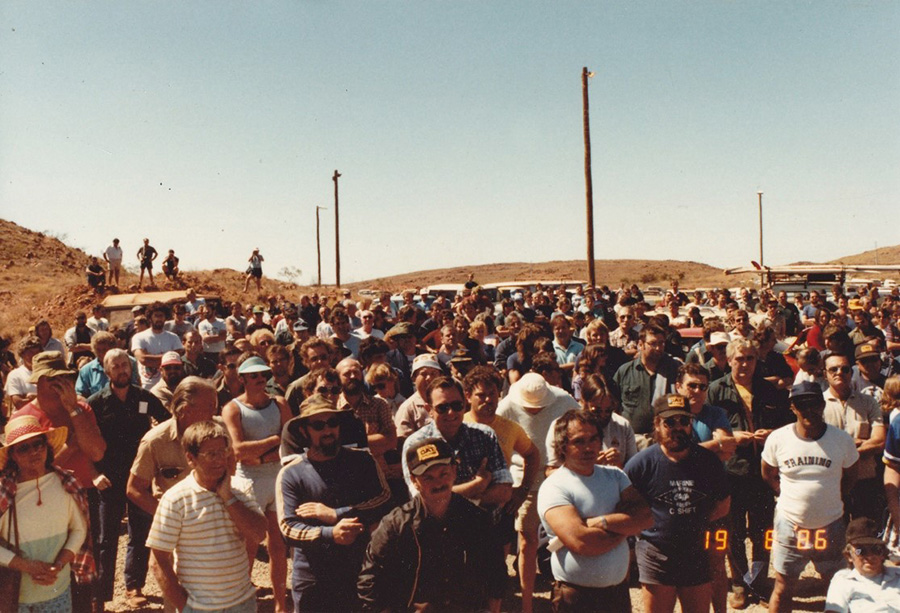
- Free Article: No
- Contents Category: History
- Review Article: Yes
- Article Title: Invisible frontier
- Article Subtitle: An extractive history
- Online Only: No
- Custom Highlight Text:
The history of the Pilbara is distinctive, but its contours are those of Australian history in miniature. Successive resource booms have saddled that part of Western Australia with the weight of immense national expectation. The rise and fall of trade unionism was compressed into a few short decades in the Pilbara’s iron ore mines, where compulsory unionism once made workers immensely powerful, and where the decline in union membership now leaves them highly exposed to managerial agendas.
- Featured Image (400px * 250px):

- Alt Tag (Featured Image): Joshua Black reviews ‘Striking Ore: The rise and fall of union power in the Pilbara’ by Alexis Vassiley
- Book 1 Title: Striking Ore
- Book 1 Subtitle: The rise and fall of union power in the Pilbara
- Book 1 Biblio: Monash University Publishing, $39.99 pb, 277 pp
- Book 1 Cover Small (400 x 600):

- Book 1 Cover (800 x 1200):

- Book 1 Readings Link: https://www.readings.com.au/product/9781923192218/striking-ore--alexis-vassiley--2025--9781923192218#rac:jokjjzr6ly9m
Such treasures are acutely vulnerable in our aggressively extractive present. Rio Tinto infamously destroyed a sacred Puutu Kunti Kurrama site at Juukan Gorge to facilitate the expansion of its mining operations. In recent weeks, the re-elected federal government has approved a fifty-year extension to Woodside’s North West Shelf project, which may well produce pollutants that rapidly erode the rock art at nearby Murujuga.
Australian culture and the world’s atmosphere both suffer from these developments. That those who actually do the mining stand to benefit much is also far from clear. The mining companies who derive so much wealth from their activities in the Pilbara are at pains to keep it that way.
As I write, The Australian Financial Review reports that Rio Tinto has offered its signal technicians wage rises in the order of $20,000 just to avoid a union-sponsored agreement. BHP has taken the Australian Workers’ Union to the Fair Work Commission in high dudgeon over the union’s Facebook posts. In case we were in any doubt, the AFR says these episodes are part of a ‘broader pushback against the reunionisation’ of the Pilbara workforce.
Alexis Vassiley’s Striking Ore: The rise and fall of union power in the Pilbara feels like it was written for this very moment. He relates the end of the national export embargo and the rapid development of the iron ore industry in the 1960s, the growing union density and industrial militancy of the 1970s and 1980s, and the bitter struggles between miners and their employers over what Vassiley, borrowing from Richard Hyman, calls the ‘invisible frontier of control’ in the workplace.
The finest quality of Striking Ore is its sociological insight into how unionism thrived in the Pilbara. That it did so was hardly inevitable. David Lee points out in The Second Rush (2016) that workers and bosses had geographical isolation and exposure to global competition in common. Vassiley shows that, in the era before mobile phones and the internet, collective power resided not in the offices of salaried union officials in Perth or Melbourne (in Vassiley’s terms, the ‘union bureaucracy’), but rather with the shop stewards, combined union committees, and a novel cohort of convenors who, at the height of their influence, were able to work solely on union affairs during company time. Life in the company towns was such that unionism was ‘intimately bound up with workers’ lives and identity’.
 Locked-out workers during the Robe River dispute, 19 August 1986 (photograph by Graeme Haynes)
Locked-out workers during the Robe River dispute, 19 August 1986 (photograph by Graeme Haynes)
Vassiley’s rich and original oral history interviews bring the industrial and the personal to life. The workers themselves remember what it meant to go on strike and win improvements in their wages and conditions; defend union preference in employment on worksites; secure influence over staffing levels, occupational demarcations, town living conditions; and even acquire the right to accrue annual leave during industrial action. Vassiley brings a sharp tactical analysis to his account of organised labour’s tug-of-war with managers, especially in his skilful accounts of worker confrontations with Hamersley Iron in 1979 and 1982 and BHP at Mount Newman in 1988. These gains were reversed in a series of industrial disputes across the Pilbara, beginning with Peko-Wallsend’s lockout of union workers at Robe River in 1986-87 (which led to workforce reductions and the winding back of many hard-won conditions) and culminating in BHP’s introduction of individual contracts at Mount Newman in 1999.
What went wrong? Vassiley identifies a few factors, some more convincing than others. Much blame is placed at the feet of the aforementioned ‘union bureaucracy’, particularly WA Trades and Labour Council Secretary Peter Cook and Australian Council of Trade Unions President Simon Crean, who appear only during missions to set up consultative bodies or negotiate workers’ surrender at the end of major industrial conflict.
Together with Prime Minister Bob Hawke and ACTU secretary Bill Kelty, such union officials were responsible for the Labor-Union Accords, which Vassiley identifies as another determinative factor in trade union decline. By signing up to the Accords and setting up tripartite forums in the sector, union bureaucrats ‘clawed back influence from grassroots unionists’ and jealously guarded their own place in what the New Right for its own reasons around this time was beginning to call the ‘industrial relations club’.
There was, Vassiley adds, a lack of ‘coherent political leadership’ among local unionists when, in the face of the Accords, such leadership was sorely needed. The Robe River dispute is emblematic; this was an ‘unnecessary defeat’, for which union officials’ moderation and Labor’s ‘class collaboration’ were largely responsible.
Striking Ore places a little too much emphasis on that dispute. Indeed, Vasiley outlines some highly distinct economic and political conditions that gave rise to that strike. Afterwards, the whole thing seemed, as Frank Bongiorno noted in The Eighties (2015), merely ‘an illustration of the costs of open industrial warfare’.
By all accounts (including this one), the real killer of unionism in the Pilbara was the introduction of individual contracts during the heady days of enterprise bargaining reform in the 1990s. This, too, was a by-product of the Accords, though in Western Australia it was the Liberal government of Richard Court that gave force to the new individual contract regime. Vassiley notes that Hamersley Iron’s workforce went from total collective bargaining in 1992 to ninety per cent individual contract coverage just eighteen months later.
Striking Ore illuminates what has been lost through that transformation. Collective power was supplanted by contractors and fly-in-fly-out workers whose large pay packets came with a personal, social, and emotional toll. Women have reported various kinds of sexual coercion from managers who have little to fear in the way of organised backlash. First Nations people can no longer have a large union community in their corner when mining companies treat their sacred sites with contempt.
These are the consequences of union decline in the Pilbara. They are also the most urgent arguments for its re-unionisation.

Comments powered by CComment